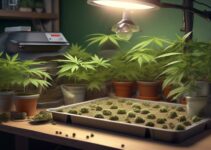Did you know that maximizing outdoor cannabis seed germination success can increase your overall yield by up to 30%? Achieving successful germination is the first step towards a bountiful harvest, and it all starts with the germination process. From choosing the right germination method to providing ideal growing conditions, there are several factors to consider. By implementing the best practices and techniques, you can significantly improve your outdoor cannabis seed germination success. So, how can you ensure that your cannabis seeds germinate successfully and thrive in an outdoor environment?
Key Takeaways
- Optimal germination conditions for cannabis seeds include a temperature range of 22-25°C (71-77°F), damp but not wet conditions, and a relative humidity of 70-90%.
- Different germination methods can be used, such as the glass of water approach, wet kitchen towel method, or direct planting into soil.
- Well-draining soil and maintaining the appropriate temperature, humidity, and moisture levels are crucial for successful germination.
- Light and temperature control are important factors for ideal growing conditions, and fluorescent lights are recommended for germination.
Optimal Germination Temperature
What is the ideal temperature range for successful germination of cannabis seeds? The ideal temperature range for successful germination of cannabis seeds is between 22-25°C (71-77°F). Maintaining this optimal germination temperature is crucial for the successful germination of cannabis seeds. It is essential to create a growing environment that is damp, but not wet, to facilitate the germination process. Additionally, relative humidity levels should be within the range of 70-90% to maximize outdoor cannabis seed germination success. When germinating cannabis seeds, it is important to provide the best light possible. Seeds favor fluorescent lighting and minimal handling during the germination process. Consistent monitoring and adjustment of temperature and humidity levels can significantly enhance germination success. Direct sunlight should be avoided during the germination process to prevent root rot. By ensuring that the ideal temperature and humidity levels are maintained, and providing suitable lighting conditions, you can effectively germinate weed seeds and set the stage for healthy plant growth.
Choosing the Right Germination Method
Maintaining the ideal temperature and humidity levels is crucial for successful germination of cannabis seeds. When choosing the right germination method for outdoor cannabis seed germination, it's essential to consider the best temperature to germinate seeds and to create optimal conditions for the germination process. Here are three effective germination methods to consider:
- Glass of Water Approach: Fill a glass with water at 22°C (71°F) and transfer germinated seeds to soil pots after 3-5 days. Use a fluorescent light for growth and avoid overwatering seeds at the early stage.
- Wet Kitchen Towel Method: Place damp kitchen towels on a flat surface, space seeds a few centimeters apart, cover with another damp kitchen towel, and then transfer germinated seeds to soil pots.
- Direct Planting Into Soil: Fill pots with soaked premium-quality soil, make holes 0.4-0.6 inches deep, place seeds in the holes, lightly cover, and keep the soil moist while placing pots in a damp climate within the temperature range.
These methods provide different approaches to germinate cannabis seeds, each with its own benefits and considerations for outdoor cannabis seed germination.
Providing Ideal Growing Conditions
To ensure successful outdoor cannabis seed germination, maintain a temperature range of 22-25°C (71-77°F) and a relative humidity of 70-90%. Provide a damp, not wet, growing environment, and use fluorescent lighting to support germination while minimizing seed handling. Utilize high-quality soil medium and avoid overwatering to give seeds the best start.
Soil and Water
For optimal outdoor cannabis seed germination, ensure the soil is well-draining and maintain a damp, not wet, growing environment for the seeds. Ensure a temperature range of 22-25°C (71-77°F) and a relative humidity of 70-90% for ideal germination conditions. Use a plant mister to keep the soil damp and avoid overwatering the seeds at the early stage. Consider using methods like the glass of water approach, wet kitchen towel method, planting directly into soil, or using stone wool blocks for successful germination. Additionally, consider using germination products like RQS Soil Plugs or the Royal Queen Seeds Feminized Starter Kit for optimal seedling growth and development. By following these guidelines, you can maximize the success of outdoor cannabis seed germination.
Light and Temperature
Ensure the success of outdoor cannabis seed germination by meticulously controlling the light and temperature to provide ideal growing conditions. Germination is the process that sets the stage for a successful yield, so it's crucial to ensure optimal light exposure and temperature. Start the light cycle with 18-24 hours of light per day to mimic the sun's natural cycle, as this helps in germinating cannabis. Growing lights to germinate should be fluorescent, providing the right spectrum for seedling growth. Temperature is equally important, aiming for a consistent range of 22-25°C (71-77°F). Dark-colored seeds have a higher chance of germination, so pay attention to seed quality. By following these guidelines, you can maximize yield and set the stage for healthy, productive plants.
Light and Its Role in Germination
Light plays a crucial role in the germination process by signaling to the seeds that it's time to begin growing. The presence or absence of light helps seeds determine the direction in which to grow. Providing the right amount of light can encourage healthy and strong seedling growth.
- The hours of light per day are crucial for the germination of seeds.
- Different types of cannabis seeds, such as photoperiod seeds and autoflowering seeds, have specific light cycle requirements during germination.
- The growing environment should have the right balance of moisture and light to support the germination process.
To ensure successful germination, it's essential to consider the specific light needs of the seeds being germinated. Using a low-intensity fluorescent light positioned 2-4 inches away from the seeds can provide the ideal light conditions for germination. Additionally, avoiding overexposure to direct sunlight is important, as it can lead to the drying out of germinating seeds. Conversely, insufficient light can result in weak and elongated seedlings. Maintaining the appropriate balance of light and moisture in the growing medium is essential for promoting healthy seedling development.
Managing Seedling Growth
To foster healthy seedling growth, it is crucial to provide adequate light and maintain the optimal distance for optimal development. After seeds have successfully germinated, managing seedling growth becomes a critical aspect of growing healthy outdoor cannabis plants. Light cycles should be carefully managed to provide the seedlings with 18-24 hours of light during the vegetative stage, promoting robust growth. It is essential to prevent mold and other issues by ensuring proper ventilation and airflow around the growing plants. Overwatering should be avoided as it can lead to damping-off and other moisture-related problems. Instead, maintain consistent moisture levels in the soil, ensuring it remains moist but not waterlogged. Using high-quality soil with good drainage is vital for supporting the healthy development of the seedlings' roots. Regular monitoring of temperature and humidity levels is necessary to create an environment conducive to healthy seedling growth. Additionally, protecting the seedlings from pests and diseases through preventive measures and regular inspection is crucial for successful seedling management.
Comparing Seeds Vs. Clones
When deciding between seeds and clones for your outdoor cannabis cultivation, it's essential to consider the unique advantages and drawbacks of each option. Seeds offer genetic diversity and the potential for distinct traits, but require germination time and may exhibit variability in growth and cannabinoid profile. On the other hand, clones provide genetic uniformity and faster growth, ensuring specific traits and characteristics, but may not offer the same level of experimentation and diversity as seeds. Understanding the pros and cons of seeds versus clones is crucial in determining the most suitable approach for your cannabis growing endeavors.
Seeds Vs. Clones
Seeds and clones represent two distinct methods of propagating cannabis plants, each with its own advantages and considerations. When deciding between seeds and clones for your outdoor marijuana grow, consider the following:
- Genetic Diversity: Marijuana Seeds offer genetic diversity, potentially leading to more robust plants with unique characteristics.
- Ease of Access: Clones are a great option for growers who want to replicate a specific strain without having to go through the germination process.
- Regulatory Compliance: It's important to note that the Food and Drug Administration and other regulatory bodies may have different rules and considerations for seeds vs. clones, so be sure to research and comply with regulations when deciding how to Grow Cannabis Outdoors.
When choosing between seeds and clones, consider your specific needs and goals for your outdoor marijuana grow.
Pros and Cons
For outdoor cannabis cultivation, carefully weighing the pros and cons of both seeds and clones is crucial for making informed decisions that align with your specific goals and circumstances. Seeds offer genetic diversity, taproot development, and adaptability to new environments. They also have a longer shelf life and are more legally accessible. However, seeds take longer to grow, may lead to inconsistent plant traits, and carry the risk of unsuccessful germination and obtaining undesirable male plants. To germinate your cannabis seeds successfully, they need warmth, moisture, and light per day. Clones, on the other hand, offer genetic uniformity, faster growth, and immediate access to mature plants but may be more prone to pests and diseases. Consider the trade-offs when deciding between seeds and clones for growing cannabis.
Outdoor Germination Tips
To ensure successful outdoor cannabis seed germination, select high-quality, dark-colored seeds, as they have a higher likelihood of germinating successfully. When germinating cannabis seeds outdoors, it's essential to follow specific tips for optimal results. Here are some outdoor germination tips to help you start the process successfully:
- Light Cycle: Ensure that the seeds receive the appropriate amount of light during the germination process. Outdoor germination should take place in an area with ample natural light or supplemented with artificial light if necessary.
- Seed Shell: Keep an eye on the seedlings and watch for the emergence of the taproot. If the taproot starts to grow, but the seed shell remains intact, gently remove the shell to prevent it from inhibiting the seedling's growth.
- Moisture: Maintain a consistently moist growing environment, but be careful not to overwater. The soil should be damp but not waterlogged to provide the ideal conditions for germination.
Following these outdoor germination tips can help ensure that your cannabis seeds germinate successfully in an outdoor environment, setting the stage for healthy and robust plant growth.
Ensuring Successful Seedling Care
Inspecting seeds thoroughly before planting ensures the quality and sets the stage for successful seedling care. Maximize outdoor cannabis seed germination success by evaluating seeds for size, color, and firmness. It's important to start germinating weed seeds with a high germination potential. For successful seedling care, ensure that the seeds to germinate contain less than 10% moisture. Start by soaking the seeds in water for 14-18 hours until they sink to the bottom, indicating readiness for planting. After your seeds have germinated, carefully remove the seed shell to prevent damage to the delicate seedling. Ensure the ideal temperature range of 22-25°C (71-77°F) and a relative humidity of 70-90% to promote healthy growth. Monitor the germinated seeds daily and adjust environmental conditions as needed. Utilize recommended germination products like RQS Soil Plugs to provide the ideal growing medium for your seedlings. By following these steps, you can ensure successful seedling care and set the stage for robust outdoor cannabis growth.
Frequently Asked Questions
How Can I Speed up My Cannabis Germination?
To speed up cannabis germination, soak your seeds for 24 hours, then place them on a moist paper towel on a heat mat. Ensure water pH is 6-7 and provide air circulation. Carefully monitor seed moisture for successful seedling growth.
Do Cannabis Seeds Germinate Better in Light or Dark?
Cannabis seeds germinate better in the dark. Dark seeds have a higher success rate. Avoid pale green or white seeds. Check for quality before planting. Provide a consistently dark and damp environment for successful germination.
What Are the Best Temps for Germinating Cannabis Seeds?
For cannabis seed germination, maintain optimal conditions with consistent temperatures of 22-25°C. Control moisture and use proper germination methods to ensure seed viability, root development, and high germination rates. Care for seedlings to promote successful germination and growth.
What Are the Most Important Factors During Cannabis Germination?
During cannabis germination, seed moisture, soil temperature, seed depth, humidity level, air circulation, nutrient availability, seed viability, germination time, seedling health, and root development are crucial factors for successful outcomes. Maintaining optimal conditions is essential.





